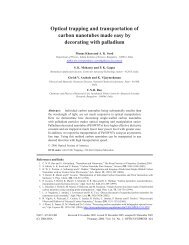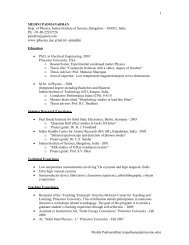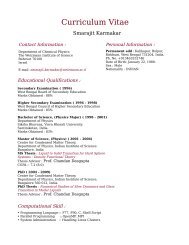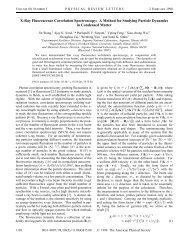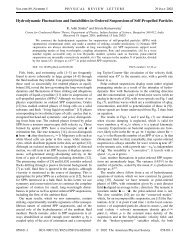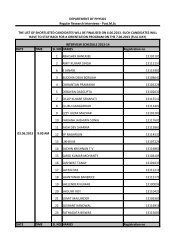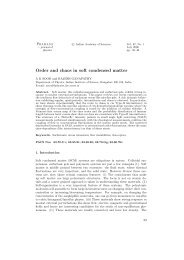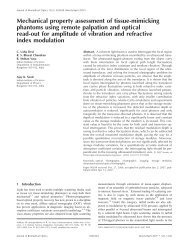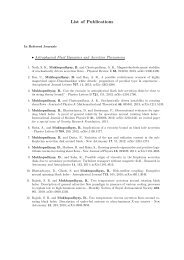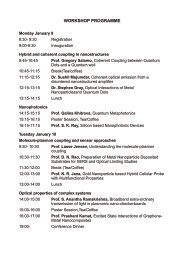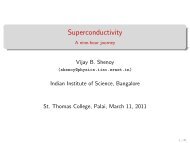Thermoelectric Properties of Fe0.2Co3.8Sb12-xTex ... - Physics
Thermoelectric Properties of Fe0.2Co3.8Sb12-xTex ... - Physics
Thermoelectric Properties of Fe0.2Co3.8Sb12-xTex ... - Physics
Create successful ePaper yourself
Turn your PDF publications into a flip-book with our unique Google optimized e-Paper software.
Low frequency noise in Topological Insulator Bi 1.5 Sb 0.4 Te 1.7 Se 1.3<br />
Semonti Bhattacharyya, Mitali Banerjee, Hariharan N, Saurav Islam<br />
Suja Elizabeth and Arindam Ghosh<br />
Department <strong>of</strong> <strong>Physics</strong>, Indian Institute <strong>of</strong> Science, Bangalore 560012<br />
ABSTRACT<br />
Topological insulator is a new quantum state <strong>of</strong> matter which exhibits exotic metallic surface states in the<br />
bulk insulating band gap. These surface states are protected from back scattering by high spin-orbit<br />
coupling and time reversal symmetry. Probing these surface states using electrical transport measurement<br />
is a challenging task because <strong>of</strong> natural bulk doping present in the crystals caused by defects or<br />
imperfections (Se vacancies in case <strong>of</strong> Bi 2 Se 3 and antisite defects in case <strong>of</strong> Bi 2 Te 3 ). Bi 1.5 Sb 0.4 Te 1.7 Se 1.3 has<br />
proved to be one <strong>of</strong> the best compositions to achieve maximal surface transport as donors and acceptors<br />
compensate each other in this material (1). We have studied electronic transport in mechanically<br />
exfoliated thick (~150 nm) and thin (>15 nm) flakes <strong>of</strong> Bi 1.5 Sb 0.4 Te 1.7 Se 1.3. For thick crystals the<br />
temperature dependence <strong>of</strong> resistance shows activated-type behavior whereas for thin crystals it shows<br />
metallic behavior. It is also observed that in thick crystals the resistance starts saturating at 50 K<br />
indicating the onset <strong>of</strong> surface transport. The magnitude <strong>of</strong> “1/f” noise in these thick samples decreases in<br />
the temperature range between 200K to 80 K; then it starts increasing and finally reaches a maximum at<br />
~18K.This data suggests that “1/f” noise can be used as an important tool to identify the contribution <strong>of</strong><br />
surface states in electronic transport. The gate voltage dependence <strong>of</strong> noise shows that the noise<br />
magnitude also increases with decreasing carrier density. For thin samples the magnitude <strong>of</strong> 1/f noise<br />
increases at lower temperatures and with decreasing carrier densities.<br />
1. PHYSICAL REVIEW B84, 165311 (2011)<br />
PDF Created with deskPDF PDF Writer - Trial :: http://www.docudesk.com



